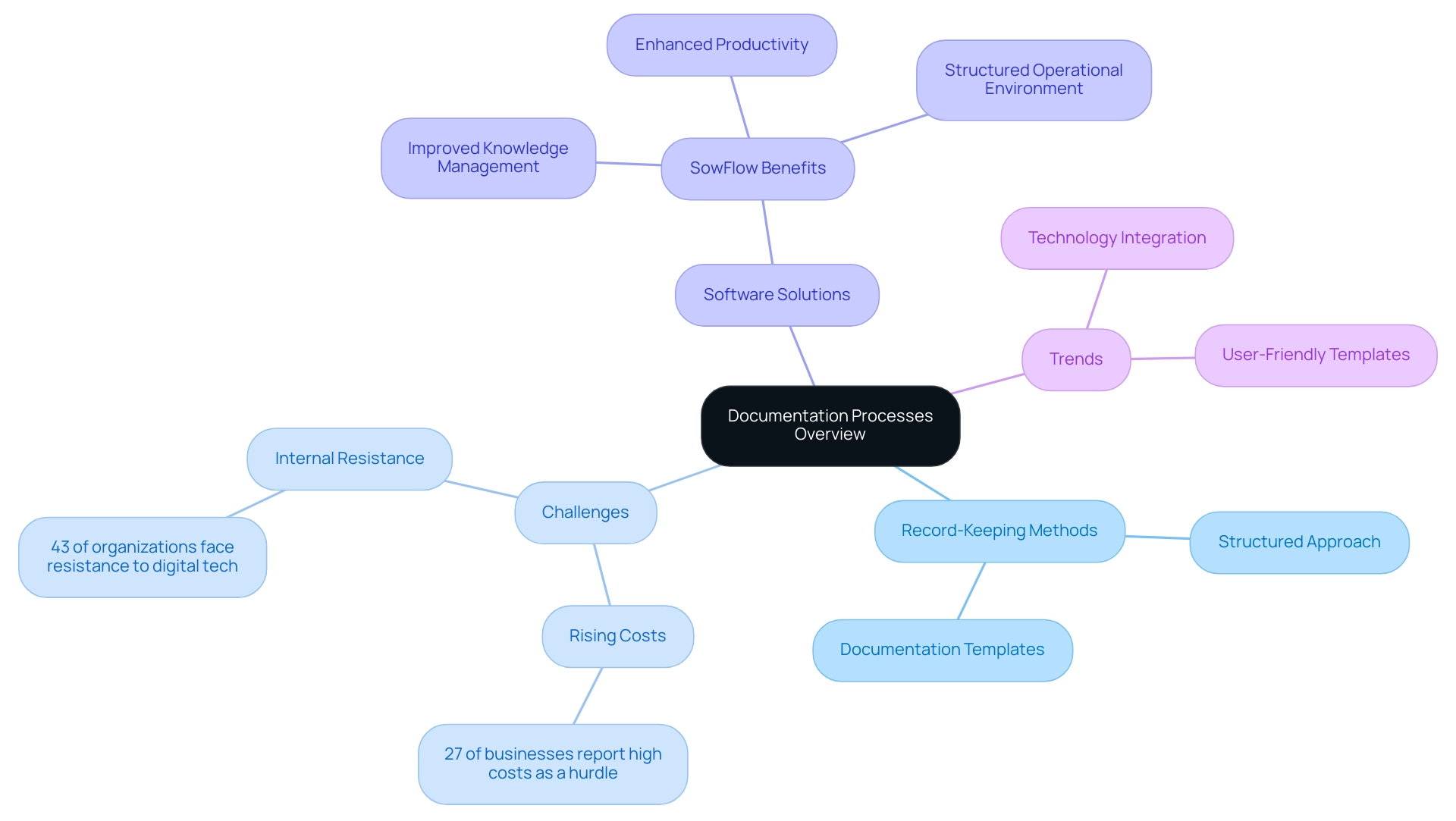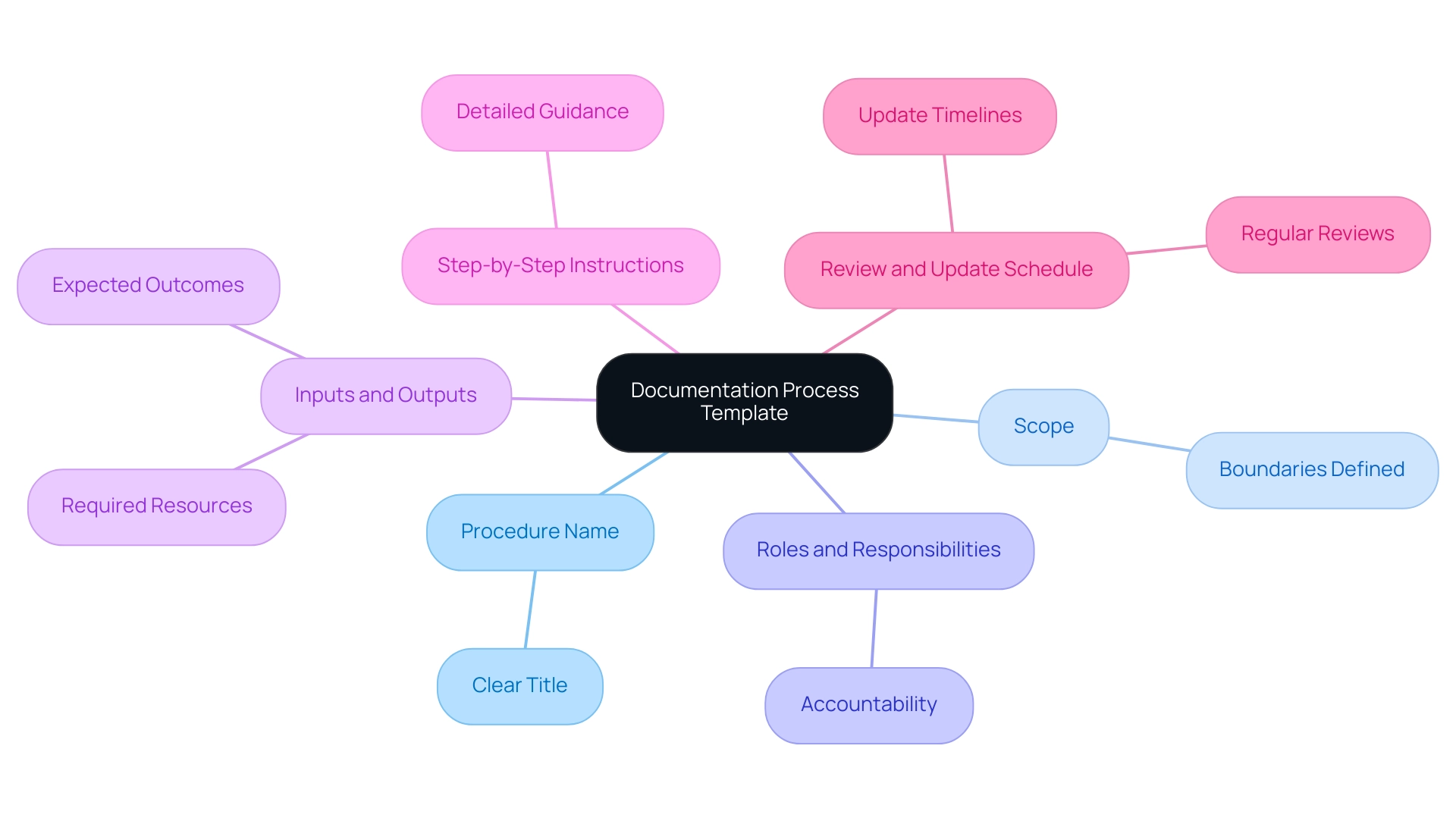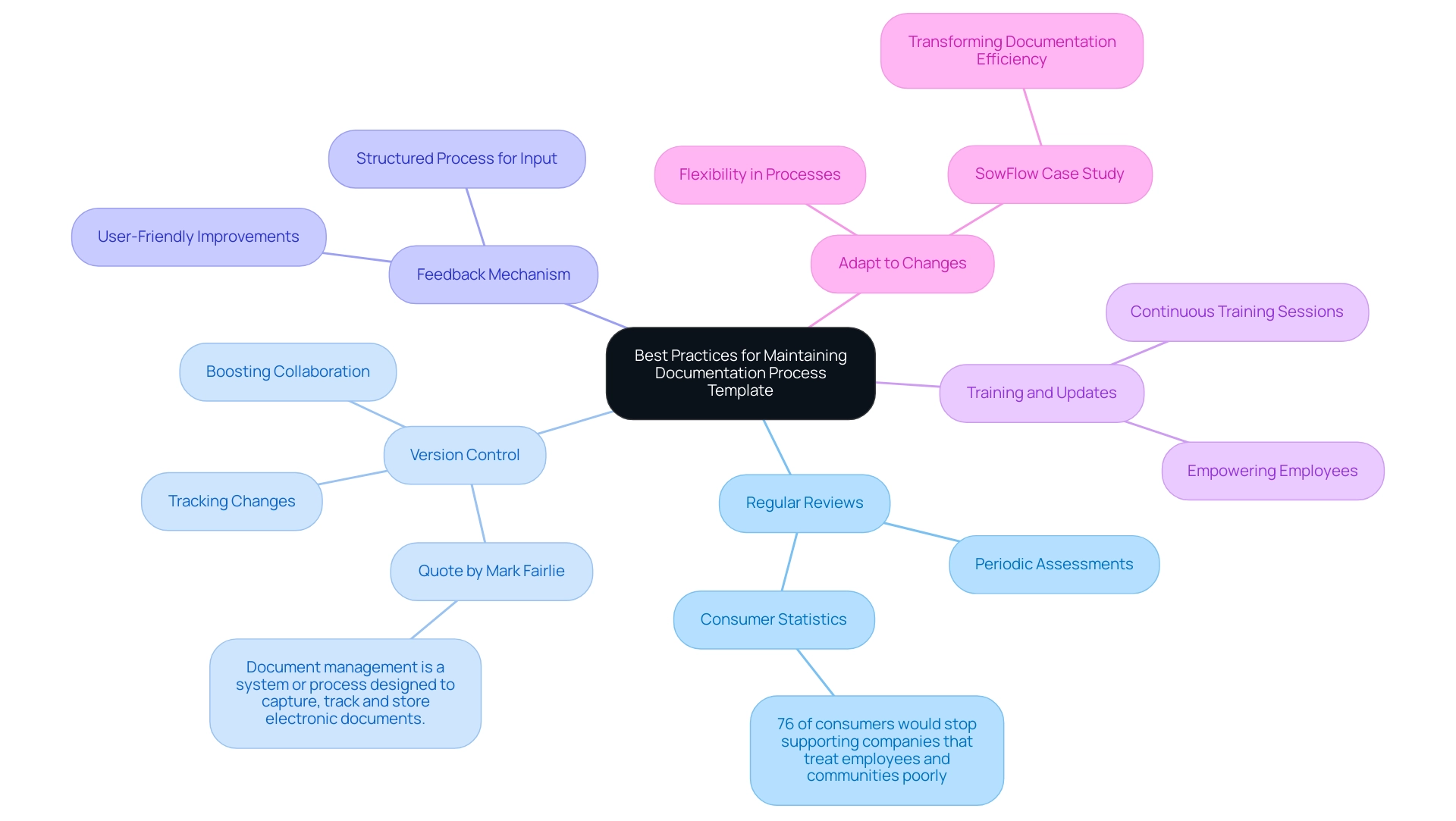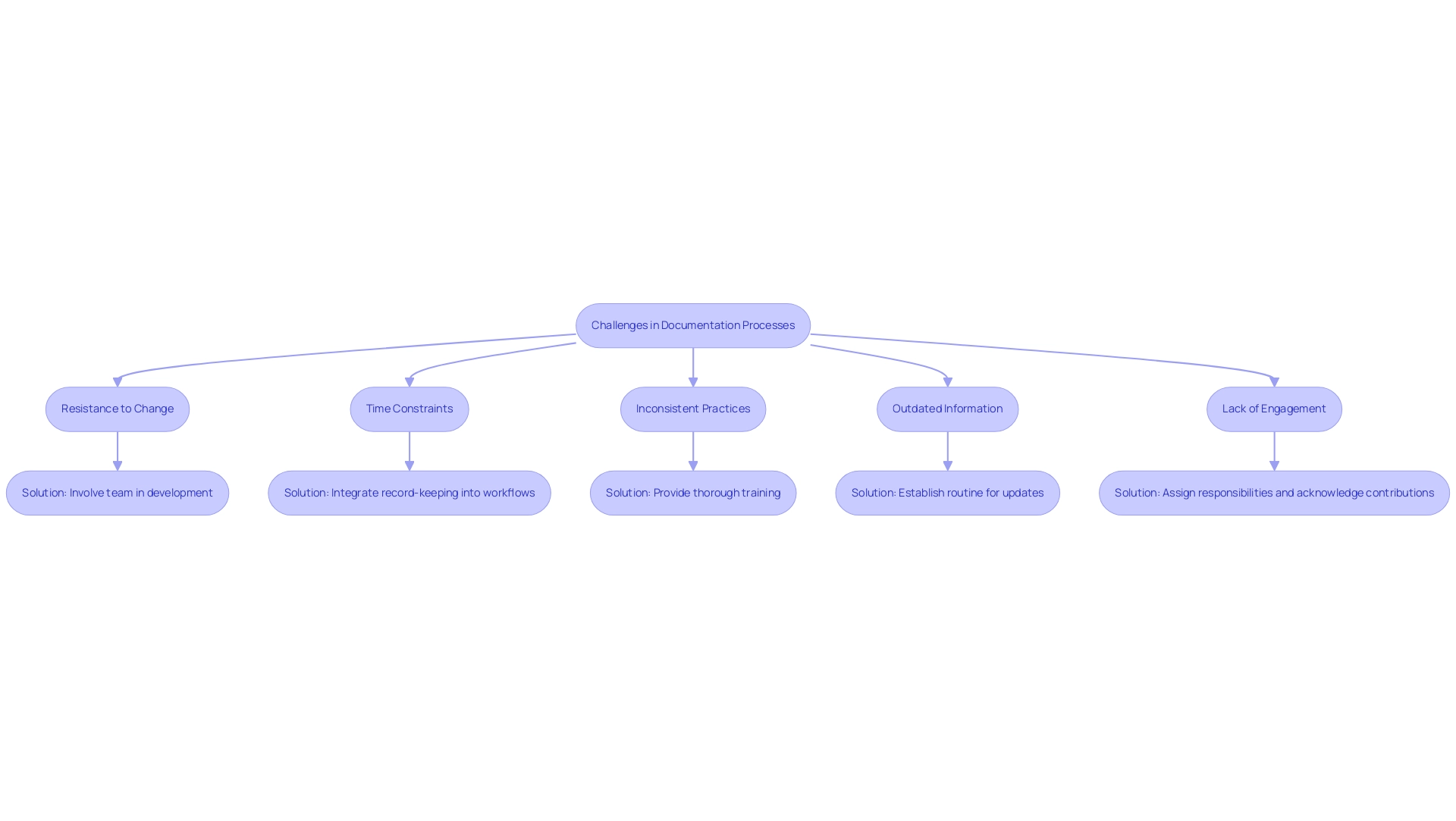
Process Improvement through Documentation
|
October 16, 2025
|
Creating Your Documentation Process Template: A Friendly Step-by-Step Guide
Overview
You might be wondering why creating a documentation process template is so important. Well, it’s crucial for boosting organizational efficiency and keeping records in check! A well-structured template not only standardizes how we document things, making it easier for everyone to access information, but it also helps tackle common hurdles like resistance to change and outdated info. How? By encouraging regular reviews and getting users involved in the process! So, let’s dive into why this matters and how it can transform your documentation practices.
Key Highlights:
- Structured documentation processes are essential for effective record-keeping within organizations.
- A clear documentation process template enhances accessibility, relevance, and efficiency of information.
- The North American document management software market is valued at $2.79 billion, indicating significant investment in record-keeping solutions.
- Challenges in adopting digital record-keeping include rising costs (27% of businesses) and internal resistance (43%).
- SowFlow's record-keeping system improves productivity and scalability by streamlining documentation processes.
- Standardized documentation promotes uniformity, saving time and enhancing communication quality.
- 47% of businesses that digitized workflows gained new customers due to improved efficiency.
- Key components of an effective documentation process template include procedure name, scope, roles, inputs/outputs, step-by-step instructions, and review schedules.
- Regular reviews and version control are crucial for maintaining accurate and relevant documentation.
- Common challenges in implementing documentation processes include resistance to change, time constraints, inconsistent practices, outdated information, and lack of engagement.
Introduction
In the ever-changing world of modern business, you might be wondering just how crucial efficient documentation processes really are. As organizations work to boost productivity and streamline their operations, a well-structured approach to documentation stands out as a key ingredient for success.
With digital tools on the rise and a growing need for knowledge sharing, companies are pouring resources into solutions that not only make documentation easier but also foster collaboration and accessibility. But let’s be real: the path to effective documentation isn’t always smooth. From employees resisting change to the tricky task of keeping information up-to-date, there are plenty of hurdles to jump over.
So, in this article, we’ll explore the essential elements of a successful documentation process, the perks of using structured templates, and some best practices to tackle those pesky obstacles. Together, we’ll help your organization on its journey toward operational excellence.
Understanding Documentation Processes: An Overview
You might be wondering what record-keeping methods really entail. Well, they’re all about having a structured approach to producing, overseeing, and preserving records within an organization. This means figuring out what essential information needs documenting, organizing it effectively, and using the right tools to manage everything smoothly. Having a clear documentation process template is super important—it keeps information easily accessible, up-to-date, and relevant for everyone involved.
Now, fast forward to 2025, and it’s clear that organizations are really starting to recognize how these methods can streamline operations and boost knowledge sharing among their teams. Did you know that in North America is valued at a whopping $2.79 billion? That’s a clear sign that businesses are investing heavily in efficient record-keeping solutions. But it’s not all smooth sailing; 27% of businesses say that rising costs are a big hurdle when it comes to going paperless, and 43% struggle with internal resistance to adopting digital tech.
But here’s the thing: effective records management isn’t just about having the right tools. It’s also about understanding the ins and outs of record processes. For example, organizations using SowFlow's record-keeping system have seen some pretty impressive boosts in productivity and scalability. By either outsourcing their record-keeping or using SowFlow's software, they’ve cut down on time spent managing records, improved knowledge management, and created a more structured operational environment.
This really tackles the challenges we mentioned earlier. SowFlow helps ease those rising costs and internal pushback with its user-friendly solutions.
Speaking of trends, there’s definitely a shift towards organized record management. Companies are focusing on creating user-friendly documentation process templates and guides that help with onboarding and standardization. As Tetiana Lebedieva, Lead Technical Communicator at SoftServe, put it, "Thank you, Tetiana! This was really insightful. I agree on chatbots; they seem to be a huge trend now!" This highlights the growing trend of incorporating technology into record-keeping methods. As businesses navigate the complexities of modern operations, the importance of effective record-keeping methods can’t be overstated.
They really are the backbone of organizational efficiency, allowing teams to collaborate effortlessly and access crucial information without unnecessary delays.

The Importance of a Structured Documentation Process
You might be wondering how a systematic approach using a documentation process template can really make a difference for organizations looking to optimize their operations in 2025. Well, it’s all about promoting uniformity across materials. When everyone follows the same guidelines, it helps maintain quality and coherence in communication. Plus, this method can save a ton of time on creating and updating records, letting teams focus on what really matters: core business activities.
Take it from Anastasia Masadi, a Product Owner, who says, "SowFlow has been a game changer in the way we document work and deliver to our clients. I do not have to take each screenshot separately, and do not even have to leave the browser while I am creating SOPs and training materials. SowFlow gave me time from my life back." This kind of feedback really highlights how SowFlow transforms efficiency, allowing for instant SOP creation and boosting productivity with features like seamless screenshot integration and in-browser editing.
But wait, there’s more! The perks of organized records go beyond just saving time; they also make knowledge management a breeze. Employees can quickly find and use the information they need, which cuts down on confusion and streamlines workflows. In fact, did you know that 47% of businesses that have digitized their document workflows report gaining new customers thanks to improved efficiency?
Now, let’s dive into how using a documentation process template can profoundly impact operational efficiency. The Intelligent Document Processing (IDP) market is booming, driven by automation and AI technologies, which shows just how crucial structured records have become. Organizations that embrace a documentation process template can really harness automation to streamline their operations and boost overall efficiency.
Case studies back this up, showing that companies with structured record-keeping processes see dramatic gains in efficiency and cost savings. By standardizing their documentation process template, teams can work more effectively, reducing the risk of errors and enhancing productivity. Tajammul Pangarkar, a seasoned expert in industry research, puts it well: "Consistency and efficiency in record-keeping are paramount for achieving operational excellence."
This really underscores how organized records can foster . So, in conclusion, implementing an organized record-keeping system not only ramps up group productivity but also sets organizations up for sustainable growth in an increasingly competitive landscape.
Key Components of an Effective Documentation Process Template
is super important for ensuring clarity and consistency in operations. You might be wondering how to make this happen—well, with SowFlow's innovative solutions, teams can empower themselves with instant access to documentation. This transforms the way user guides are created and updated, making the whole process a breeze. SowFlow offers an easy creation experience that lets you craft user guides effortlessly.
So, what should your template include? Here are some key components to consider:
- Procedure Name: Start by clearly defining the title of the procedure you’re documenting. This helps avoid confusion and ensures easy identification.
- Scope: Outline the boundaries of the procedure. What’s included? What’s excluded? This sets clear expectations and limits, which is always a good thing.
- Roles and Responsibilities: Who’s accountable for each aspect of the task? Clarifying this fosters accountability and ensures that everyone on the team knows their contributions.
- Inputs and Outputs: Specify what you need to kick off the task and what you expect to get out of it. This is crucial for understanding the flow of information and resources.
- Step-by-Step Instructions: Provide detailed instructions on how to execute the process. Make it comprehensive enough to guide users through each stage, minimizing the risk of errors.
- Review and Update Schedule: Establish a timeline for regular reviews and updates. Given that 42% of employees struggle to find and share information, keeping records current is vital for operational efficiency. With SowFlow's instant record-keeping solution, updates become effortless, significantly reducing confusion and boosting productivity.
Incorporating these elements not only enhances the effectiveness of your records but also aligns with best practices seen in successful companies. For instance, organizations that have embraced organized record-keeping methods often report notable boosts in productivity and operational effectiveness. One case study even illustrates how a community-driven approach saved millions in support costs and significantly improved customer satisfaction—just ask Sandy Rivas, ex-Senior Program Manager at Microsoft.
Thinking about simplifying your record handling? Companies might want to consider using SowFlow's leading document management software solutions. By following these guidelines, you can develop a documentation process template that not only meets your immediate needs but also adapts to the ever-evolving landscape of your operations. Want to experience the benefits of SowFlow's solutions? Request an invite today and take your record-keeping to the next level!

Step-by-Step Guide to Creating Your Documentation Process Template
Developing an efficient documentation process template is super important for optimizing operations and boosting productivity. With SowFlow's innovative solution, you can easily follow these steps to whip up a comprehensive template:
- Identify the Process: You might be wondering, which specific process should you document? This could be anything from onboarding new hires to standardizing operational procedures.
- Define the Scope: Next, let’s clearly outline what your written material will cover. This means specifying the objectives and the audience for the materials, ensuring it meets the needs of everyone involved.
- Gather Information: Now it’s time to collect all the relevant info. Think existing records, stakeholder input, and any pertinent data. Engaging with your team can really provide insights that enhance the quality of your documentation.
- Draft the Template: Using the key elements you’ve identified, go ahead and create a draft of your template. Make sure it’s structured logically so it’s easy for users to follow. lets you record workflows directly from your browser, making it super efficient to capture processes. Plus, with just a single command, you can access your documentation, saving you from those unnecessary meetings where you’re just searching for answers.
- Review with Stakeholders: Share that draft with your group for feedback. This collaborative approach not only enhances the template but also fosters a sense of ownership among everyone involved.
- Finalize the Template: Take the feedback you received and finalize the template. Make sure it’s clear, concise, and accessible to all users. Don’t forget, documentation needs to be current and updated alongside product or process development. Luckily, SowFlow makes this effortless with instant updates.
- Implement and Train: Finally, roll out that finalized template and provide training to ensure everyone knows how to use it effectively. This step is crucial—did you know that 70% of group members believe that reducing meetings and emails would significantly boost productivity? Training will help clear up confusion and improve adoption of the new procedure.
By following these steps, organizations can create a documentation process template that reflects current processes and adapts to ongoing changes. For example, in a case study on data science record-keeping best practices, teams that customized their materials to specific project needs saw improved project execution and stakeholder satisfaction. This really highlights the importance of a tailored method in creating template designs that address various stakeholder interests, all further supported by SowFlow's instant solutions.
Best Practices for Maintaining Your Documentation Process Template
To effectively maintain your documentation process template, let’s chat about some best practices you might find helpful:
- Regular Reviews: You might be wondering, how often should I check my records? Conducting periodic assessments is key to keeping everything accurate and relevant. This practice not only helps you spot outdated information but also underscores the importance of maintaining records that align with current organizational processes. Did you know that 76% of consumers would stop supporting companies that treat employees and communities poorly? This really highlights the need for effective records to uphold a positive reputation!
- Version Control: Now, let’s dive into version control. Implementing a solid version control system is essential for tracking changes and updates. This way, everyone on your team is working with the most current info, which cuts down on confusion and boosts collaboration. As Mark Fairlie, a Senior Analyst, puts it, "Document management is a system or method designed to capture, track and store electronic documents." This really emphasizes how crucial efficient tracking is in record-keeping.
- Feedback Mechanism: Have you thought about how to gather input from your team? Establishing a structured process for group members to share their thoughts on the records can lead to some fantastic improvements. Encouraging feedback makes the materials more user-friendly and effective.
- Training and Updates: Speaking of improvements, providing continuous training sessions for your team on how to use and refresh the records is a game changer. This not only empowers your employees but also fosters a culture of continuous improvement and accountability in record-keeping.
- Adapt to Changes: Finally, let’s talk about staying flexible. Being ready to adjust your recording process as your organization evolves is crucial. This agility ensures that your records remain relevant and continue to meet your team's needs, especially in a fast-paced business environment. For example, SowFlow has transformed how teams document work and deliver to clients, allowing users to create SOPs and training materials without leaving the browser—talk about saving time! This shift in record efficiency is echoed in client testimonials, showcasing how SowFlow enables teams to create SOPs instantly and boost productivity.
By sticking to these best practices, organizations can really enhance their record-keeping systems using a documentation process template, ensuring it remains a valuable resource for all team members. Plus, with on the rise, keeping precise and relevant records is vital to avoid hefty fines and improve data protection. SowFlow specifically addresses these challenges by offering features that simplify record-keeping, making compliance and efficiency a breeze.

Overcoming Challenges in Implementing Documentation Processes
Establishing record-keeping methods can be a bit tricky, right? You might be wondering what common obstacles pop up and how to tackle them effectively.
- Resistance to Change: Let’s face it, employees often hesitate to adopt new record-keeping practices. To ease this resistance, why not involve your team in developing the documentation method? Clearly communicating the benefits—like improved efficiency and less confusion—can work wonders.
- Time Constraints: Feeling pressed for time to adequately record processes? Statistics show that 48% of employees struggle to find documents quickly, which can lead to frustrations with confusing filing systems. To counter this, cultivate a culture of record-keeping by weaving it into daily workflows. Encourage your groups to see records as an essential part of their jobs, not just an extra chore.
- Inconsistent Practices: Variability in record-keeping can create chaos and inefficiencies. Make sure everyone on your team receives thorough training on the record-keeping process to keep things consistent across the board.
- Outdated Information: Documentation can go stale pretty fast if it’s not regularly reviewed and updated. Establish a routine for revisiting and refreshing your documentation process to ensure that everything stays relevant and useful. Implementing can help by ensuring access to the most up-to-date information, cutting down on data duplication, and boosting overall document accessibility across platforms.
- Lack of Engagement: A disengaged team can lead to poor-quality records. To foster a sense of ownership, assign specific record-keeping responsibilities to team members and acknowledge their contributions. This strategy not only boosts engagement but also enhances the quality of your written materials.
By addressing these challenges head-on, organizations can create a more effective and streamlined process. As Kimberlee Leonard points out, River is built for scale, but its user-friendly interfaces make it a great fit for businesses of all sizes. The case study titled 'Inefficiencies in File Management' highlights how many employees end up recreating files because they can’t locate the originals, wasting both time and resources. By adopting a cloud-based document management system, organizations can significantly reduce these frustrations and elevate their documentation practices.

Conclusion
You know, efficient documentation processes aren't just about keeping things running smoothly; they're really the backbone of success in today’s fast-paced business world. When you get to grips with the ins and outs of documentation, you can set up a structured approach that boosts clarity, consistency, and teamwork. Take tools like SowFlow, for example—they’ve shown some impressive results in productivity, helping teams streamline their documentation efforts and cut down on time spent on those tedious tasks.
Now, let’s talk about structured documentation templates. They’re super important! By including key elements like:
- Clear roles
- Step-by-step instructions
- A review schedule
organizations can really step up their knowledge management and operational efficiency. And don’t forget about best practices! Regular reviews and feedback loops keep your documentation fresh and user-friendly, helping to create a culture of continuous improvement.
Sure, there are challenges like resistance to change and time constraints, but don’t let that hold you back! Engaging your team in the documentation process and weaving it into daily workflows can help you tackle these hurdles. By doing this, you’re setting your business up for sustainable growth and operational excellence. As the business landscape continues to shift, making effective documentation practices a priority will be key to achieving success and staying ahead of the competition. So, what are you waiting for? Let’s dive into improving those documentation practices together!
Frequently Asked Questions
What are record-keeping methods?
Record-keeping methods involve a structured approach to producing, overseeing, and preserving records within an organization. This includes determining essential information to document, organizing it effectively, and using appropriate tools for management.
Why is having a clear documentation process template important?
A clear documentation process template is crucial because it ensures that information is easily accessible, up-to-date, and relevant for everyone involved, thereby streamlining operations.
How is the document management software market performing?
The document management software market in North America is valued at approximately $2.79 billion, indicating significant investment by businesses in efficient record-keeping solutions.
What challenges do businesses face in adopting digital record-keeping?
Businesses face challenges such as rising costs, with 27% citing this as a hurdle to going paperless, and 43% struggling with internal resistance to adopting digital technology.
How can organizations improve productivity and scalability in record-keeping?
Organizations can improve productivity and scalability by using systems like SowFlow's record-keeping software or outsourcing their record management, which helps reduce time spent managing records and enhances knowledge management.
What is a current trend in record management?
There is a trend towards organized record management, with companies focusing on creating user-friendly documentation process templates and guides to aid onboarding and standardization.
How does a systematic approach using a documentation process template benefit organizations?
A systematic approach promotes uniformity across materials, maintains quality and coherence in communication, and saves time on record creation and updates, allowing teams to concentrate on core business activities.
What impact does organized record-keeping have on knowledge management?
Organized record-keeping simplifies knowledge management by enabling employees to quickly find and utilize necessary information, which reduces confusion and streamlines workflows.
What role does automation and AI play in record-keeping?
The Intelligent Document Processing (IDP) market is growing due to automation and AI technologies, highlighting the importance of structured records in enhancing operational efficiency.
What are the overall benefits of implementing an organized record-keeping system?
An organized record-keeping system improves group productivity, fosters a productive work environment, and positions organizations for sustainable growth in a competitive landscape.
👍
What others are liking
5 Steps to outline your ideal documentation structure
5 MINS READ
Where to start the your journey of mapping out your ideal documentation structure, aligning it with the very heartbeat of your organization?
Defining a winning level of detail in your process
3 MINS READ
What is too much detail, and what is too little? This article described in that winning level detail about what detail is enough.





